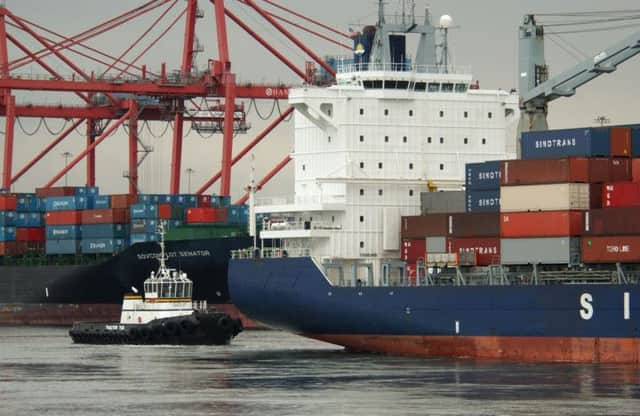All at sea with EU’s bid to cut pollution


ON 1 January 2015 a new EU Sulphur Directive comes into force aiming to reduce the amount of sulphur produced by merchant vessels in the North Sea. Its purpose is to cut pollution, which is having a big environmental impact in Europe; particularly Scandinavia.
SEStran supports moves to improve the environmental friendliness of water transport, as a mode that already has the potential to play a major role in sustainably transporting passengers and freight within the region and further afield.
Advertisement
Hide AdAdvertisement
Hide AdSignificant amounts of freight already move through the various container and oil-related services operating to and from Grangemouth. South-east Scotland is also home to Scotland’s sole direct sea freight link to Europe in the Rosyth to Zeebrugge freight ferry service.
Despite their potential to move large quantities of traffic off-road, ferry services present environmental problems of their own, which the EU directive seeks to address. Typically they use “Bunker” fuels which produce high quantities of sulphur and other pollutants. The directive will reduce the acceptable sulphur output from engines from the current 1.5 per cent to 0.1 per cent in ships plying the North Sea routes.
This is a laudable aim and will make a significant contribution towards reducing carbon emission from merchant vessels. However, it presents operators with problems.There are many solutions available to shipping lines affected by the Directive. They can refit vessels with new engines that use cleaner fuels. These new engines may use myriad alternatives, ranging from Marine Gas Oil (MGO), to Liquid Natural gas (LNG), liquid hydrogen and possibly even hybrid engines, which include electronic components.
These alternative fuels would improve upon the sulphur output of bunker fuels, but they are more expensive, have potentially major implications for the fuel production industry and, in the case of LNG, are not readily available in the UK. Demand for the new fuels will lead to price rises, with a potential knock-on effect on sources of fuel used in all modes of transportation. There is also the question of what to do with the remaining bunker fuels.
Another option is to fit existing vessels with scrubbers. These devices, attached to the ships funnel, filter out emissions, but are extremely heavy and may destabilise ships. Waste products filtered out by the scrubbers also need to be disposed of appropriately. Finally, depending on the age of the vessel, the only realistic option may be to purchase a replacement. Whatever option is chosen, operators face a bill to bring services in line with the directive running into millions.These added costs may mean particular services cease to be viable. This would have the unintended consequence that cargoes will clock up hundreds of road miles travelling to the remaining services. So we face the very real prospect of a reduction in available services, as providers, faced with a heavy bill for refitting or replacing vessels, cut services; a new dependence upon scarce fuel supplies not readily available domestically; increased road traffic as goods are transported to a smaller number of available shipping services – and the question of how to dispose of the remaining bunker fuels.
Add to this the fact that the directive will apply only to shipping operating from the east coast of the UK, not the west, where Bunker fuels will still be allowed, and we face the possibility the EU Directive might exacerbate the very problems it seeks to address.
SEStran supports a cleaner, more environmentally friendly fleet, but believes the EU must provide support to service providers if they are to comply with the directive’s aims without reducing existing services or facing commercially unviable expenses. We are therefore commissioning a study through the Transport Research Institute at Napier University looking at ferry services for freight and passengers in light of the directive and the kind of support the EU has given ferry service providers elsewhere. The results will feed into European freight projects like Foodport and Weastflows that are investigating sustainable freight transport and in which SEStran is an active partner.
Cutting emissions is essential, but will only be achieved without consequences that will compromise the very aims of the EU Sulphur Directive if steps are taken to ensure ferry services can continue at the same levels of service that exist today, with the longer term aim of increasing waterborne transportation in future.
• Cllr Russell Imrie is Chair of SEStran (South East of Scotland Transport Partnership), www.sestran.gov.uk
SEE ALSO